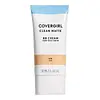Neutrogena Healthy Skin Anti-Aging Perfector SPF 20 Versus Covergirl Clean Matte BB Cream For Oily Skin
What's inside
What's inside
 Key Ingredients
Key Ingredients

 Benefits
Benefits

 Concerns
Concerns

 Ingredients Side-by-side
Ingredients Side-by-side

Ethylhexyl Methoxycinnamate 7%
UV AbsorberEthylhexyl Salicylate 3%
UV AbsorberWater
Skin ConditioningTitanium Dioxide
Cosmetic ColorantIsopropyl Isostearate
EmollientCyclopentasiloxane
EmollientDimethicone
EmollientButylene Glycol
HumectantGlyceryl Stearate
EmollientCetyl Alcohol
EmollientCetearyl Alcohol
EmollientPEG-75 Stearate
Lauroyl Lysine
Skin ConditioningTocopheryl Acetate
AntioxidantOlea Europaea Fruit Extract
BleachingBHT
AntioxidantErythorbic Acid
AntioxidantBisabolol
MaskingRetinyl Palmitate
Skin ConditioningRetinol
Skin ConditioningArginine
MaskingSilica
AbrasivePolysorbate 20
EmulsifyingPEG-100 Stearate
Isostearyl Palmitate
EmollientSclerotium Gum
Emulsion StabilisingPolysilicone-11
Ammonium Polyacryloyldimethyl Taurate
Emulsion StabilisingCeteth-20
CleansingSteareth-20
CleansingTetrasodium EDTA
Iron Oxides
Methylparaben
PreservativePropylparaben
PreservativeEthylparaben
PreservativePhenoxyethanol
PreservativeParfum
MaskingEthylhexyl Methoxycinnamate 7%, Ethylhexyl Salicylate 3%, Water, Titanium Dioxide, Isopropyl Isostearate, Cyclopentasiloxane, Dimethicone, Butylene Glycol, Glyceryl Stearate, Cetyl Alcohol, Cetearyl Alcohol, PEG-75 Stearate, Lauroyl Lysine, Tocopheryl Acetate, Olea Europaea Fruit Extract, BHT, Erythorbic Acid, Bisabolol, Retinyl Palmitate, Retinol, Arginine, Silica, Polysorbate 20, PEG-100 Stearate, Isostearyl Palmitate, Sclerotium Gum, Polysilicone-11, Ammonium Polyacryloyldimethyl Taurate, Ceteth-20, Steareth-20, Tetrasodium EDTA, Iron Oxides, Methylparaben, Propylparaben, Ethylparaben, Phenoxyethanol, Parfum
Water
Skin ConditioningCyclopentasiloxane
EmollientPropylene Glycol
HumectantTalc
AbrasiveDimethicone
EmollientAluminum Starch Octenylsuccinate
AbsorbentSodium Chloride
MaskingPEG/PPG-18/18 Dimethicone
EmulsifyingPvp
Emulsion StabilisingBenzyl Alcohol
PerfumingSilica
AbrasivePhenoxyethanol
PreservativeEthylene/Methacrylate Copolymer
Synthetic Beeswax
Emulsion StabilisingTrihydroxystearin
Skin ConditioningMethicone
EmollientSodium Benzoate
MaskingSynthetic Wax
AbrasivePolyglyceryl-4 Isostearate
EmulsifyingCetyl PEG/PPG-10/1 Dimethicone
EmulsifyingHexyl Laurate
EmollientIsopropyl Titanium Triisostearate
EmollientEthylene Brassylate
MaskingPolyethylene
AbrasiveCI 77891
Cosmetic ColorantCI 77491
Cosmetic ColorantCI 77492
Cosmetic ColorantCI 77499
Cosmetic ColorantWater, Cyclopentasiloxane, Propylene Glycol, Talc, Dimethicone, Aluminum Starch Octenylsuccinate, Sodium Chloride, PEG/PPG-18/18 Dimethicone, Pvp, Benzyl Alcohol, Silica, Phenoxyethanol, Ethylene/Methacrylate Copolymer, Synthetic Beeswax, Trihydroxystearin, Methicone, Sodium Benzoate, Synthetic Wax, Polyglyceryl-4 Isostearate, Cetyl PEG/PPG-10/1 Dimethicone, Hexyl Laurate, Isopropyl Titanium Triisostearate, Ethylene Brassylate, Polyethylene, CI 77891, CI 77491, CI 77492, CI 77499
Ingredients Explained
These ingredients are found in both products.
Ingredients higher up in an ingredient list are typically present in a larger amount.
Cyclopentasiloxane, or D5, is a silicone used to improve texture of products and trap moisture.
D5 is considered lightweight and volatile. Volatile means it evaporates quickly after application. Once evaporated, D5 leaves a thin barrier that helps keep skin hydrated.
It is also an emollient. Emollients help soften the skin and prevent water loss. Silicones create a silky texture in products. D5 helps other ingredients become more spreadable.
Studies show D5 is safe to use in skincare products. We recommend speaking with a skincare professional if you have concerns.
Learn more about CyclopentasiloxaneDimethicone is a type of synthetic silicone created from natural materials such as quartz.
What it does:
Dimethicone comes in different viscosities:
Depending on the viscosity, dimethicone has different properties.
Ingredients lists don't always show which type is used, so we recommend reaching out to the brand if you have questions about the viscosity.
This ingredient is unlikely to cause irritation because it does not get absorbed into skin. However, people with silicone allergies should be careful about using this ingredient.
Note: Dimethicone may contribute to pilling. This is because it is not oil or water soluble, so pilling may occur when layered with products. When mixed with heavy oils in a formula, the outcome is also quite greasy.
Learn more about DimethiconePhenoxyethanol is a preservative that has germicide, antimicrobial, and aromatic properties. Studies show that phenoxyethanol can prevent microbial growth. By itself, it has a scent that is similar to that of a rose.
It's often used in formulations along with Caprylyl Glycol to preserve the shelf life of products.
Silica, also known as silicon dioxide, is a naturally occurring mineral. It is used as a fine, spherical, and porous powder in cosmetics.
Though it has exfoliant properties, the function of silica varies depending on the product.
The unique structure of silica enhances the spreadability and adds smoothness, making it a great texture enhancer.
It is also used as an active carrier, emulsifier, and mattifier due to its ability to absorb excess oil.
In some products, tiny microneedles called spicules are made from silica or hydrolyzed sponge. When you rub them in, they lightly polish away dead skin layers and enhance the penetration of active ingredients.
Learn more about SilicaWater. It's the most common cosmetic ingredient of all. You'll usually see it at the top of ingredient lists, meaning that it makes up the largest part of the product.
So why is it so popular? Water most often acts as a solvent - this means that it helps dissolve other ingredients into the formulation.
You'll also recognize water as that liquid we all need to stay alive. If you see this, drink a glass of water. Stay hydrated!
Learn more about Water